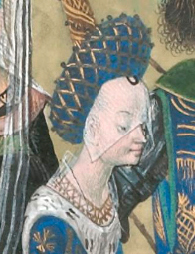
Christine de Pizan or Pisan, was an Italian-born French poet and court writer for King Charles VI of France and several French dukes.

Isabella of Valois was Queen of England as the wife of Richard II, King of England, between 1396 and 1399, and Duchess of Orléans as the wife of Charles, Duke of Orléans, from 1406 until her death in 1409. She had been born a princess of France as the daughter of King Charles VI and Isabeau of Bavaria.

Louis I of Orléans was Duke of Orléans from 1392 to his death. He was also Duke of Touraine (1386–1392), Count of Valois (1386?–1406) Blois (1397–1407), Angoulême (1404–1407), Périgord (1400–1407) and Soissons (1404–07).

Isabeau of Bavaria was Queen of France from 1385 to 1422. She was born into the House of Wittelsbach as the only daughter of Duke Stephen III of Bavaria-Ingolstadt and Taddea Visconti of Milan. At age 15 or 16, Isabeau was sent to France to marry the young King Charles VI; the couple wed three days after their first meeting. In 1389, she was honored with a lavish coronation ceremony and entry into Paris.

Charlotte of France was the second child and second daughter of King Francis I and his wife Claude.

Valentina Visconti was a countess of Vertus, and duchess consort of Orléans as the wife of Louis I, Duke of Orléans, the younger brother of King Charles VI of France. As duchess of Orléans she was at court and acquired the enmity of the Queen of France, Isabeau of Bavaria-Ingolstadt, and was subsequently banned from the court and had to leave Paris. Due to political animosity, Valentina's husband was murdered in 1407. She died on 4 December 1408.

Margaret of Valois, Duchess of Berry was Duchess of Savoy by marriage to Duke Emmanuel Philibert of Savoy. She was the daughter of King Francis I of France and Claude, Duchess of Brittany.
Stephen III, called the Magnificent or the Fop, was the Duke of Bavaria-Ingolstadt from 1375. He was the eldest son of Stephen II and Elizabeth of Sicily.

Louis VII, called the Bearded was the Duke of Bavaria-Ingolstadt from 1413 until 1443. He was a son of Duke Stephen III and Taddea Visconti.

John of Orléans, Count of Angoulême and of Périgord, was a younger son of Louis I, Duke of Orléans, and Valentina Visconti, and a grandson of Charles V of France. He was the younger brother of the noted poet, Charles, Duke of Orléans, and grandfather of Francis I of France.

Margaret of Nevers, also known as Margaret of Burgundy, was Dauphine of France and Duchess of Guyenne as the daughter-in-law of King Charles VI of France. A pawn in the dynastic struggles between her family and in-laws during the Hundred Years' War, Margaret was regarded as the future Queen of France at two separate times, as a result of her two marriages: first to the Dauphin and second to the Duke of Brittany.

The Bal des Ardents or the Bal des Sauvages, was a masquerade ball held on 28 January 1393 in Paris at which Charles VI of France performed in a dance with five members of the French nobility. Four of the dancers were killed in a fire caused by a torch brought in by Charles's brother Louis I, Duke of Orléans.

Isabella of France was a French princess and member of the House of Valois, as well as the wife of Gian Galeazzo Visconti, who after her death became Duke of Milan.

Taddea Visconti, Duchess of Bavaria was an Italian noblewoman of the Visconti family, the ruling house in Milan from 1277 to 1447. She was the first wife of Stephen III, Duke of Bavaria, and the mother of the French queen Isabeau of Bavaria.
Anne de Bourbon was a daughter of John I, Count of La Marche and his wife Catherine of Vendôme. She was a member of the House of Bourbon.
Gabrielle Michele Spiegel is an American historian of medieval France, and the current Krieger-Eisenhower Professor of History at Johns Hopkins University where she served as chair for the history department for six years, and acting and interim dean of faculty. She also served as dean of humanities at the University of California, Los Angeles in 2004–2005, and, from 2008 to 2009, she was the president of the American Historical Association. In 2011, she was elected as a fellow to the American Academy of Arts and Sciences.
Rita Felski is an academic and critic, who holds the John Stewart Bryan Professorship of English at the University of Virginia and is a former editor of New Literary History. She is also Niels Bohr Professor at the University of Southern Denmark (2016–2021).
Lionel Gossman was a Scottish-American scholar of French literature. He taught Romance Languages at Johns Hopkins University and Princeton University, and wrote extensively on the history, theory and practice of historiography, and on aspects of German cultural history.

Michel Pintoin, commonly known as the Monk of Saint-Denis or Religieux de Saint-Denis was a French monk, cantor, and chronicle writer best known for his history of the reign of Charles VI of France. Anonymous for many centuries, in 1976 the Monk was tentatively identified as Michel Pintoin, although scholars continue to refer to him as the Monk or the Religieux.
Pierre I of Beauvau, baron of Beauvau, La Roche-sur-Yon and Champigny-sur-Veude, lord of Craon, of Sablé and Ferté-Bernard by marriage. He was an adviser for Charles VII, and chamberlain, counsellor, governor and lieutenant to dukes, Louis II, Louis III and René of Anjou.













